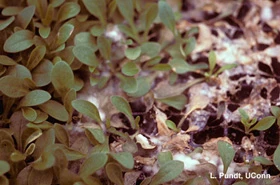
Rhizoctonia spp. cause root, stem and foliar diseases of many of the most important container-produced ornamentals. It is widely distributed and has a wide host range. The pathogen commonly causes damping-off of bedding plants, stem rot of cutting-propagated plants (like poinsettia and hydrangea) and aerial blights of woody shrubs and foliage plants (especially ferns).
This fungus usually prefers the heat, humidity and rainfall that occur in many parts of the United States during the summer. In the southeastern U.S. it can also be found in spring and fall when the environment is still favorable for its development.
How does it get in the greenhouse or nursery? Rhizoctonia is a natural inhabitant of the soil and can survive there indefinitely. It is easily introduced into the growth medium by soiled hands, tools,flats and colonized transplants. Fungus gnats and shore flies may introduce and spread this fungus within a crop.
This fungus is more active in the upper portion of the soil. In the South, Rhizoctonia can attack foliage when plants are grown close together and kept moist, decimating entire stock beds or flats in a few days when conditions are hot and wet. In other areas of the country, growers create ideal conditions for Rhizoctonia by growing plants in covered structures that are heated and irrigated overhead.
What are the symptoms? Rhizoctonia usually attack plants at the soil line, causing root loss and constriction of the stem, which results in girdling and death of the plant tops. Look for brown, irregularly shaped spots form anywhere on foliage or stems. When humidity is high, the weblike brown mycelium of the pathogen covers infected portions of the plants. Canker are sunken and dry in appearance. And watch plants for aboveground signs of root rot, including yellow or pale-green leaves, small leaves, wilting and stunting.
"Root rot may occur in some cases of stem rot, but not always. Root rot caused by Rhizoctonia appears much like root rots caused by other fungi with roots becoming brown, somewhat mushy and finally disintegrating," said Ann Chase, president of Chase Agricultural Research.
Severe disease development can occur in less than a week so plants should be scouted and monitored for symptoms once a week, she said.
How can I control Rhizoctonia? Keep hose-ends off floors. Use soil-less growing medium and clean pots and flats. Use healthy plants, new or sterilized pots and growing media and avoid placing plants directly on the ground. Try to increase space between plants if possible and manage overhead mist to minimize the amount of water or time with active mist in a propagation area, Chase said.
BioWorks can help. To prevent Rhizoctonia and other root pathogens, apply RootShield® WP or RootShield® Granules to the growing medium. This root biofungicide product contains dormant spores of the effective, and well proven, active ingredient Trichoderma harzianum strain T-22. When RootShield® WP is mixed with water at the typical application rate of 4 oz/100 gallons, over 100 billion spores are applied to the growing medium in one application. Once RootShield® WP is applied to the growing medium, the spores germinate within 16 – 24 hours. As the mycelium emerges from the spore it immediately starts coiling around the plant’s roots, growing medium particles, and any plant pathogen propagules present. After 24 hours, RootShield® can't be leached from the soil mix. RootShield® will grow in a diversity of inorganic and organic growing media from sand, perlite, or clay, to pure peat or bark. RootShield® grows tightly on roots in hydroponics systems, including those utilizing the nutrient film technique where there is no medium.
Learn more about RootShield® and how it works here:
http://www.bioworksinc.com/products/rootshield-wp/how-rootshield-wp-works.pdf
Photo courtesy of Leanne Pundt, University of Connecticut
Latest from Greenhouse Management
- Grant awarded to test western U.S. wood species for use as wood fiber potting substrate
- Pennsylvania Horticultural Society announces 2025 Gold Medal Plant winners
- Oasis Grower Solutions announces new Southeast territory sales manager
- How to reduce labor in greenhouse vegetable production
- A nation of gardeners: A history of the British horticulture industry
- Last Word with Angela Labrum, Bailey Nurseries
- Iowa plant supplier Plantpeddler building retail complex
- This month's Greenhouse Management magazine is about native plants and sustainability





